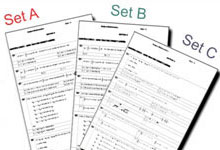



09216592130




Each paper offers extra questions. As an example: A question paper with two sections, A and B, each carrying 30 questions, with 20 to be attempted
from each. Say, a student attempts 20 questions from Section A (and gets 18 right) and 24 from Section B. How will she be evaluated?
The new marking scheme says that only the first 20 answers from Section B will be considered and the last 4 ignored. Say, the student gets 15 of the first 20 answers right. She
will be credited with 18+15 or 33 correct answers in that paper. So, if some of the answers the student was most confident about — and presumably the likeliest to get right — came after the first 20 she attempted in Section
B, she would be likely to lose out.
“This is a clear-cut message that students should attempt those questions they are most confident about. They should not attempt more than the required number of questions,” a schoolteacher said.
“If the student uses the option of un-attempted questions, then only her responses after question No. 20 will be evaluated.”
